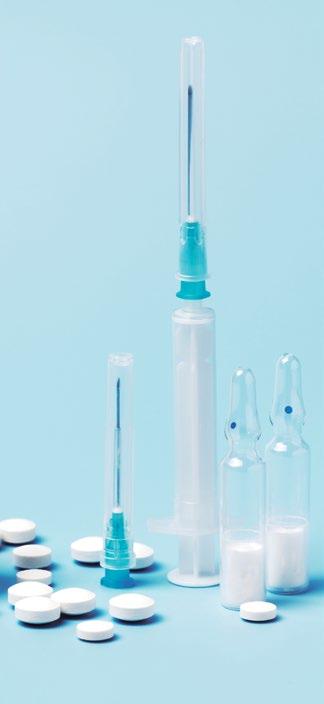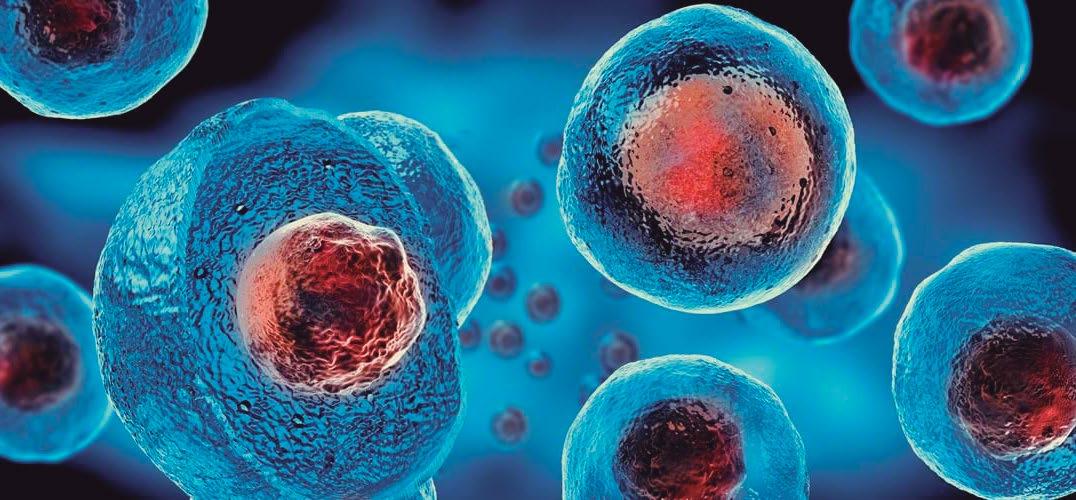
12 minute read
ANTIBIOTICS AND EDUCATION
Let us begin with a rather curious question: “Why should a child or adolescent need to know about antimicrobial resistance?” In response, we can quote the words of Stella Kyriakides, the European Commissioner for Health, at the launch of the 2020 campaign organized by the European Centre for Disease Prevention and Control (ECDC) to combat antimicrobial resistance and to preserve the effectiveness of antimicrobials.
Antimicrobial resistance is a global challenge and a top priority for the European Union. As the world continues to fight COVID-19, it is essential that we remain vigilant and committed in this fight. Antibiotics must be used prudently, with strict prevention and control measures. Both COVID-19 and antimicrobial resistance call for a united policy approach across policies, countries and all levels of society. We must take steps to prevent the spread of resistance worldwide and to support the right environment to develop new antimicrobials. We must all work together to ensure that microbial resistance does not become the next global health catastrophe.1
Advertisement
It is interesting to reflect on these words, especially as we see that, owing to the impact of the COVID-19 pandemic, governments have focused greatly on education concerning the issue, even at early levels of basic schooling and preschool. The behavior of children in the face of what they now know about the coronavirus and the precautions to be followed has led them to internalize habits and behaviors as required. This shows that, if investment is made in educational plans that are sustainable over time, children can grow up with a respectful awareness of the restrictions required to prevent the disease. Nevertheless, the very concept of Antimicrobial Resistance (AMR) has been a “sore spot” for decades, and it is alarming to observe how little is known about the misuse of antibiotics at the level of the general population.

I would like to address this need for education here, not only regarding the proper use of antibiotics, but specifically, the need to educate from an early age. The proper administration of antibiotics is clearly a pertinent matter for health professionals and older people who are responsible for children. But I would like to address some of the myths and misconceptions surrounding the use of antimicrobials in general and of antibiotics in particular ―misconceptions that are passed on to our children and young people― and about the role that modern technology can provide in reaching them.
According to a recent study by the ECDE,2 multiresistant bacteria cause 33,000 deaths in Europe every year, including 1,900 of them in Spain, with the added health expenditure that this represents: some 1.5 billion euros in all of Europe, according to the Agencia Española de Medicamentos y Productos Sanitarios (AEMPS). Antibiotic resistance is one of the greatest threats nowadays to health worldwide. It is estimated that more than 700,000 people die each year from antimicrobial-resistant infections, according to figures from the World Health Organization (WHO).
Four years after the Review on Antimicrobial Resistance (commissioned by the government of the United Kingdom and chaired by Jim O’Neill) revealed that antimicrobial resistance will be the leading cause of death by 2050,3 antimicrobial resistance continues to be one of the most pressing threats to global health, food security, and development. And this is just taking into account European figures: if we look at the statistics in Latin American countries, the situation is much more alarming.
AMR affects developing countries in a particularly worrying way. It is obvious that countries with more precarious survival systems, with restricted access to water, and with fewer hospitals and medical resources in general, will be more vulnerable in terms of public health and therefore bear the brunt of the situation. According to recent WHO figures, 40% of infections contracted by newborn babies are resistant to available treatments. Most of the resulting deaths occur in developing countries. And in these countries, a high percentage of the population believes that antibiotics cure colds.
If we briefly review the factors that still, even today, convulsed as we are by the SARS-CoV-2 pandemic as an aggravating factor, continue to affect the subject of this article (antimicrobial resistance vs. education), we find the following:
Interruption of treatment
Antibiotics should be taken regularly and for the full cycle prescribed, which usually ranges from one to six weeks. Even in places where medications are expensive or not available in time, many patients discontinue treatment when symptoms disappear, keeping the rest of the pills for later use.
Over-prescription
In areas where bacterial diseases such as diarrhea and respiratory tract infections are common, and where hospitals and health centers tend to be overwhelmed, owing to lack of capacity, antibiotics are often prescribed without proper diagnosis, or even preventively. This leads to overuse. Health professionals are also influenced by the opinions of patients or their family members, who sometimes, through their impatience, manage to pressure the doctor into prescribing the antibiotic.
The Costs of AMR
The hospitalization and treatment of a patient with an antibiotic-resistant infection generate very high costs. If immediate treatment is not available, patients will often try out other medicines in order to fight their infections, without no guarantee of success. In cases where, with correct treatment, a single course of antibiotics might be required, they end up needing a several more, considerably impacting not only family budgets but also the health systems of the affected countries. These additional costs may reach as much as one trillion US dollars by 2050, according to a 2016 report by the World Bank. As a result, a financial impact of as much as 5.0% of GDP is estimated for the most vulnerable countries by the same date. This will result in millions of dollars in losses, pushing more than 25 million people into extreme poverty, all owing to antimicrobial resistance.

Kevin Outterson, a researcher in health law at Boston University, has estimated that the total cost of eradicating antimicrobial resistance could be as high as ten billion US dollars. This is as much money as the member states of the United Nations Framework Convention on Climate Change commit to each year in support of the Green Climate Fund.4
At the same time, the current costs for the development of new drugs required to counteract the lack of efficacy of those against which resistance has developed are extremely high. Including all phases of research and development, and on through regulatory approval, it is estimated that the average cost of developing a new drug is approximately US$2.5 billion. Moreover, owing to strict international regulations, the cost of medicines remains low, making their development a less profitable process and therefore less attractive to pharmaceutical companies. Finally, data on innovation show that so-called “precision medicine” (from traditional medicine to personalized medicine)5 contributes, along with the aforementioned factors, to the fact that the return on investment today for launching a new medicine is ever lower.
These circumstances, says Outterson, result in a second reason for the drop in profitability, which is that competition between pharmaceutical companies has intensified. “Before, a molecule was alone in the market for a long time, but now there are several non-generic molecules competing for the same market. If we add up everything that is invested in the development needs of new medicines and in plans to combat AMR, we see figures in the millions.”
In developed countries, policies governing the use of antibiotics are strictly enforced and mortality due to AMR is under control. The situation is totally different, however, for more vulnerable countries. The World Health Organization estimates that, if current trends continue, the problem could account for ten million deaths a year by 2050, making AMR even more dangerous than diabetes, tuberculosis, and HIV/AIDS combined.6 Developing countries are both the cause and the victims of the problem.
Let us now consider the role of education at the primary and secondary school level in promoting knowledge and awareness of antimicrobial resistance. What has been done in the past and what is currently being done?
There is background in the medical literature on the usefulness of educational interventions in the population regarding knowledge about the appropriate use of antimicrobials. It has been observed that educational interventions with single strategies, such as the dissemination of educational material (print- or computer-based readings, and other passive methods), do not significantly improve levels of knowledge. By contrast, systematic reviews have suggested that strategies combining readings, interactive workshops, and audiovisual material, focused on the specific interests and needs of the intervention group, may have greater impact on knowledge level of the study population, which could in turn contribute to decreasing the use of antimicrobials.
The conclusions reveal important gaps in knowledge about the appropriate use of antimicrobials in the study populations, which improved significantly following the educational intervention, with benefits continuing for at least four months thereafter.7
How complicated would it be to influence younger populations, who we know have endless potential for assimilating new patterns of behavior? By consistently and reasonably instilling ―with age-appropriate language― greater awareness and knowledge about antibiotic misuse and its consequences, we would gain a future ally in this fight against the devastating effects of antimicrobial resistance.
It is necessary to harness information technology, to which a large percentage of the younger population has access, in order to generate attractive strategies, with inclusive messaging and wide diffusion, in the fight against AMR. We need to show teachers, parents, and all those involved in education how to develop and implement educational plans that include information about the misuse of antibiotics, through campaigns, competitions, games, classroom dynamics, and workshops, with clear representations of the harm caused by the misuse of antibiotics. Developing tools to raise awareness among minors about the damages and consequences of the misuse of antibiotics should be the task of governments and of all concerned. We can take advantage of the present conjuncture of the COVID-19 pandemic to develop and establish educational intervention plans in order to raise awareness among younger populations about the inappropriate use of antimicrobials.
An excellent example of the use of current resources is the ECDC’s annual European Antibiotics Awareness Day and its digital campaign, which consists of a series of filmed statements by high-level stakeholders from the European Commission and the German presidency of the Council of the European Union, as well as other experts. Each video addresses a number of key issues related to antimicrobial resistance.8

The videos were published and promoted on social media starting on 18 November 2020, under the hashtags #EAAD and #KeepAntibioticsWorking. For this first digital campaign, the ECDC hired “influencers” from the various EU member states to spread the key messages of European Antibiotics Awareness Day in their respective languages, adapting them to their specific audiences. Finally, the ECDC launched an animated presentation, aimed at hospital staffs and workers in other healthcare settings, about what health professionals could do to keep antibiotics working.
Another interesting initiative for educating the general public and particularly the younger population is the so-called Bacteria Bus, a mobile unit of the pharmaceutical company Pfizer decorated and equipped with educational material on issues concerning the proper use and the indiscriminate abuse of antibiotics. The unit travelled to several cities in Europe during the week of the abovementioned campaign in order to promote knowledge among the population about the risks of antimicrobial resistance and what can be done to prevent its spread. The Pan American Health Organization (PAHO) also generated a number of videos on the subject of AMR for community education.9
Uruguay, Argentina, Brazil, Chile, Colombia, Paraguay, and Peru all took part in the project entitled “Working Together to Combat Antimicrobial Resistance.” The Pan American Health Organization, the Food and Agriculture Organization of the United Nations, the World Organisation for Animal Health, and the European Union also joined forces to collaborate on the initiative. The approach focused on “One Health” and the vision was integral: since our food and our health are interdependent, linked to the ecosystems in which they coexist, bad practices in one of the areas affects the other.
Initiatives can be taken, but creativity is needed. What is also needed is the will and the effectiveness, in order for these initiatives to reach the populations that constitute our incipient future.
Finally, I would like to close with an important reflection on the subject of antibiotics. In 1928 the most famous and most frequently used of all antibiotics was discovered: penicillin. Its discoverer, Alexander Fleming, understanding that millions of lives could be saved, bequeathed to the world the formula of this important medicine, marking a transcendental step in the progress of humanity. Nearly one hundred years later, the challenge now is how to preserve this gift and to save millions of more lives.
A phrase to keep in mind about antibiotics: “Take them seriously!”
1. Antimicrobial resistance and consumption remains high in the EU/EEA and the UK, according to the ECDC data. Press release European Center for Desease Prevention and Control, November 18, 2020
2.Cristina Crespo Garay, “La resistencia a los antibióticos mata a 700.000 personas cada año,” National Geographic (16 November 2018), available online at: <https://www.nationalgeographic.es/ciencia/2018/11/la-resistencia-los-antibioticos-mata-700000-personas-cada-ano>.
3. O’Neill J. Review on Antimicrobial Resistance. Tackling drug-resistant infections globally: final report and recommendations. May 2016.
4. Deloitte Consulting “Ten years on. Measuring the return from pharmaceutical innovation 2019”
5. The Lancet Infectious Diseases. ECDC (European Center for Desease Prevention and Control) Nov 06, 2018
6. I+D de medicamentos: costes de desarrollo cada vez más altos y rentabilidades más bajas, FarmaIndustria Madrid, 07.02.2020
7. “Impacto de una intervención educativa en el conocimiento sobre uso adecuado de antimicrobianos en infecciones respiratorias en un grupo de adolescentes” Beatriz Silva, Clarita Ferrada y M. Elena Santolaya, Santiago, Chile. Servicio de Pediatría (BS). Universidad de Chile, Santiago. Facultad de Medicina. Julio 2012
8. European Antibiotic Awareness Day 2020 EAAD is this year marked with a digital campaign 18-24 November
9. World Antimicrobial Awareness Week, with the theme “United to preserve antimicrobials” (November 2020).

Miriam Herrera Domínguez
holds an undergraduate degree in chemistry from the Universidad Simón Bolívar (Venezuela) and a specialization in environmental sciences from the University of Ann Arbor in Michigan. She is currently technical director at Síoltalife Business Development and a business developer at Corporación Científica Venezolana, C.A. in the areas of microbiology and laboratory filtration for the pharmaceutical and biotechnology sectors in Venezuela, as well as collaborating with the Parenteral Drugs Association (PDA). With extensive experience in instrumental analysis and gas chromatography, she has been served on committees for the evaluation of industrial standards (COVENIN) in Venezuela and for ASTM International (formerly the American Society for Testing and Materials). For more than ten years she worked as regional manager (Venezuela-Ecuador-Colombia) and consultant in the areas of microbiology, biotechnology and filtration in the pharmaceutical, biotechnology and food & beverage sectors for Sartorius de México, S.A. de C.V.








